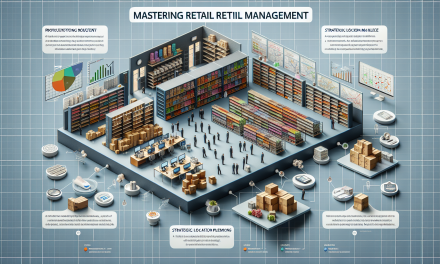Table of Contents
- Introduction
- Understanding Green Supply Chains
- The Importance of Sustainable Practices
- Key Green Supply Chain Management Practices
- Leveraging Technology for Sustainability
- Case Studies of Successful Green Initiatives
- Challenges and Solutions in Implementing Green Practices
- FAQs
- Conclusion
Introduction
In today’s world, businesses face increasing pressure to adopt sustainable practices, especially within supply chains. The shift towards environmentally friendly strategies is not just a trend; it’s a necessity for long-term viability. Thus, understanding how to implement green supply chain management practices effectively becomes crucial for organizations aiming to operate sustainably.
Understanding Green Supply Chains
The concept of green supply chains comprises various strategies aimed at minimizing environmental impacts while maximizing economic value. At its core, it integrates environmental considerations into the traditional management of supply chains. Thus, by focusing on sustainability, businesses can enhance their reputation, reduce costs, and contribute positively to the planet.
Defining Green Supply Chain Management
Green supply chain management (GSCM) emphasizes the importance of environmentally friendly practices at every stage, from procurement to production, and ultimately to delivery. It encourages companies to assess their suppliers based on sustainability efforts. Hence, incorporating eco-friendly materials, optimizing transportation routes to minimize carbon footprints, and ensuring ethical sourcing practices form a significant part of the green supply chain.
The Importance of Sustainable Practices
Sustainability in supply chain management is critical not only for meeting regulatory requirements but also for satisfying consumer demand. Today’s consumers are increasingly aware of the environmental impact of their purchases, thus often opting for brands that prioritize sustainability. Consequently, companies adopting green supply chain management practices can enhance customer loyalty, reduce waste, and improve operational efficiencies.
Enhancing Reputation
When organizations commit to sustainable practices, they enhance their brand image. The public increasingly values transparency and ethical operations. Therefore, highlighting environmentally friendly practices becomes a powerful marketing tool, attracting a loyal customer base who not only supports but advocates for businesses making a positive impact.
Cost Reduction
While many perceive sustainability as an additional cost, it often leads to significant savings. By reducing waste and optimizing resource usage, companies discover numerous avenues for cost reduction. For example, implementing recycling programs and energy-efficient processes can lead to lower operational costs in the long run.
Key Green Supply Chain Management Practices
Numerous strategies exist for implementing green practices within supply chain management. Here are several key approaches that organizations can adopt:
1. Eco-Friendly Procurement
Purchasing from suppliers who prioritize sustainability significantly impacts the overall environmental footprint of a business. This means selecting vendors who utilize environmentally friendly materials or renewable resources. Organizations can often achieve this by examining supplier certifications, such as ISO 14001, which demonstrate commitment to responsible environmental management.
2. Sustainable Logistics
Logistics plays a crucial role in the sustainability of supply chains. By optimizing transportation routes or utilizing more energy-efficient modes of transport, businesses can reduce greenhouse gas emissions. Many opt for technologies that enable better tracking and planning of logistics in order to enhance efficiency.
3. Waste Management and Recycling
Effective waste management strategies are paramount in a green supply chain. Corporations must prioritize recycling initiatives and minimize waste generation. By conducting waste audits, organizations can uncover opportunities to improve recycling rates and reduce the amount of waste sent to landfills.
Leveraging Technology for Sustainability
Technology serves as a vital component in successfully implementing green supply chain management practices. From tracking resources to improving logistics, leveraging technology leads to enhanced efficiency and decreased environmental impact.
Data Analytics for Decision Making
Utilizing data analytics allows companies to make informed decisions that align with their sustainability goals. By analyzing supply chain processes, businesses can identify areas for improvement and develop strategies that minimize resource usage.
Automation and Smart Technologies
Automation enhances supply chain flexibility while maintaining sustainability. Smart technologies such as the Internet of Things (IoT) streamline processes, allowing for real-time monitoring and adjustments. This leads to greater optimization in logistics and waste management.
Case Studies of Successful Green Initiatives
Various organizations have made substantial strides in implementing green supply chain practices. Analyzing these case studies reveals insights into effective strategies and achievable outcomes.
Case Study 1: Unilever
Unilever has long been a leader in sustainability across its supply chain. By committing to sourcing materials responsibly and reducing carbon emissions, they have demonstrated how benefit-driven practices correlate directly with financial success. In this regard, Unilever exemplifies the idea that going green can create a competitive advantage.
Case Study 2: Tesla
Tesla’s commitment to sustainability uniquely positions it in the automotive industry. By focusing on electric vehicles and renewable energy solutions, the company showcases how integrating sustainable practices can redefine an entire industry. Their green supply chain not only reduces operational impact but also attracts environmentally conscious consumers.
Challenges and Solutions in Implementing Green Practices
While the benefits of green supply chain management are clear, several challenges exist in implementing these practices.
Identifying Suitable Suppliers
Finding suppliers who align with sustainable practices can be daunting. Hence, fostering strong relationships and open communication is integral. Engaging in collaborative efforts with suppliers leads to a better understanding of shared values and economic pressures.
Estimating the Total Cost
Companies often struggle to estimate the overall costs associated with transitioning to sustainable practices. Nevertheless, a thorough analysis covering both direct and indirect costs can uncover potential long-term savings.
Employee Training
Training employees on sustainable practices isn’t merely optional; it’s necessary. Building a culture of sustainability within an organization ensures that everyone understands their role in achieving green goals. Resources like the Green Supply Chain Management Practices Course can provide valuable insight into effective strategies and techniques.
FAQs
What is Green Supply Chain Management?
Green Supply Chain Management refers to integrating environmentally friendly practices into supply chain management processes. It emphasizes reducing environmental impacts and improving sustainability across the entire supply chain.
How can businesses benefit from implementing green practices?
Focusing on green practices can enhance a company’s reputation, lead to significant cost savings, and improve operational efficiency while attracting environmentally conscious consumers.
What role does technology play in green supply chains?
Technology facilitates optimization, data analytics, and automation, enhancing the sustainability and efficiency of supply chain processes. It provides businesses with tools to track improvements and make informed decisions.
Conclusion
Embracing green supply chain management practices is no longer just beneficial; it’s imperative for sustainable business operations. As stakeholders from consumers to regulatory authorities increasingly demand responsibility, companies must prioritize eco-friendly processes. By implementing effective green strategies, leveraging technology, and fostering collaboration, organizations position themselves competitively in the market while contributing positively to the planet. This journey encapsulates not only the operational benefits but also the moral obligation we hold toward a sustainable future.
In addition, if you’re interested in enhancing your skills further, exploring topics like Mastering Advanced Procurement Skills for Today’s Professionals, Unlocking Excellence: Navigating the Purchasing Management Process, Mastering Purchasing Techniques and Negotiation for Effective Cost Reduction, Essential Guide to Mastering Project Management in Supply Chain, and Mastering Supply Chain Risk Management: Essential Skills for Today’s Professionals continues to foster growth and understanding in this vital area of business.





